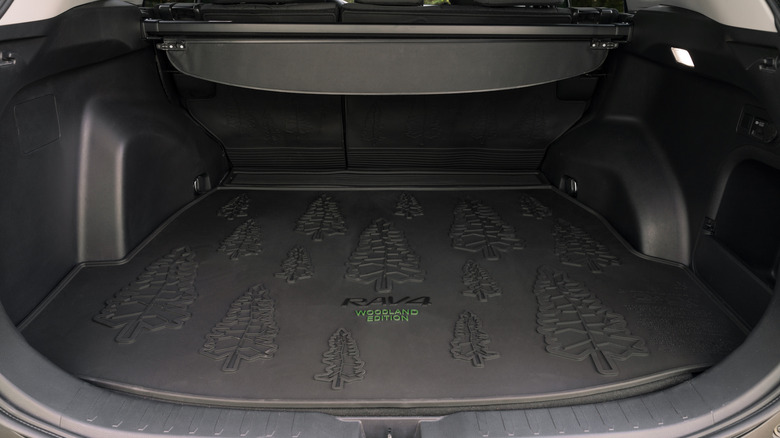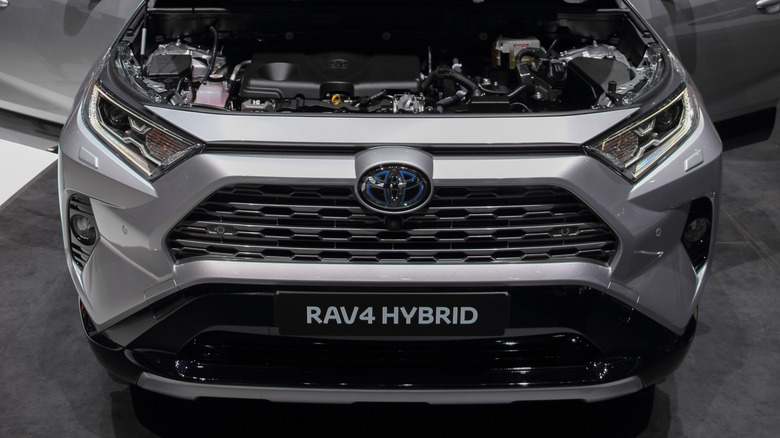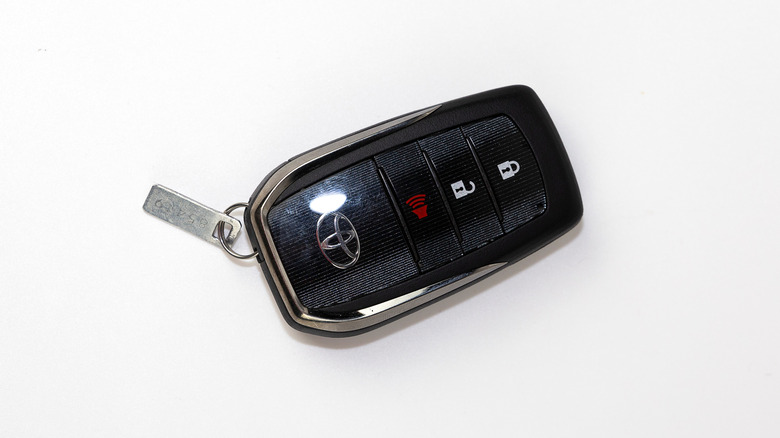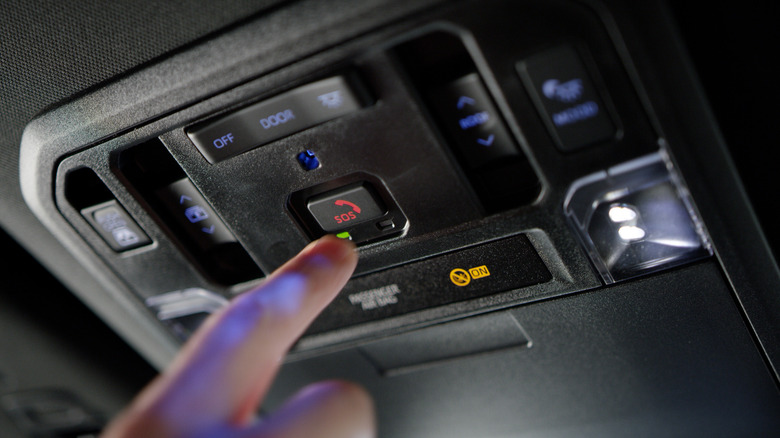12 Hidden Toyota RAV4 Features You Might Not Know About
We may receive a commission on purchases made from links.
Car owners could be missing out. When they pick up a new or used vehicle, the dealership or the private seller often fails to mention many of its neatest features. Perhaps the salesperson was in a rush because another customer was waiting, or maybe a private seller didn't even know about these features. While many of them can be found in the owner's manual, you'll probably only look in the manual if you already know the features exist.
The RAV4 is no exception to this trend. In fact, given Toyota's long-time leadership in incorporating the latest technology into their vehicles, the brand's cars, trucks, and SUVs may have more hidden features than most manufacturers. Whether it's Toyota's advanced driver assist features, the new engines Toyota will release soon, or just thoughtful conveniences that the engineers slipped into each new car, RAV4 owners could spend hours studying their owner's manuals.
This article will provide a shortcut by revealing some of the RAV4's secrets. The RAV4 is already a great option for a versatile SUV, but knowing these tricks can help to get the most out of driving it. Where possible, the model years for each feature will be specified. Your RAV4 may not have every option described below, so be sure to check your owner's manual to find out if your RAV4 includes any given option and to find out how to operate it, since equipment and procedures may vary slightly from year to year. Toyota's website has how-to videos describing how some systems work, and Toyota USA's YouTube channel has collected many RAV4 how-to videos into a playlist.
Reversible dual-height cargo floor
Owners expect their SUVs to provide extra utility beyond a sedan or hatchback. The RAV4 takes that to the next level with a trick cargo floor that can be set to two different heights or flipped over for carrying messy loads on the plastic side. This feature can be found on RAV4s beginning with the 2019 model.
When the cargo floor is set to the upper level, it makes a flat loading surface with the rear seats folded forward. At the lower level, it provides more than two extra inches of vertical space within the cargo area. For dirty loads and wet paws, flip the carpeted cargo floor over and expose the hard plastic underside.
Some owners have reported that the cargo floor sags under heavy loads, especially when set to the upper level where there is a gap between the floor and the spare tire underneath it. They've shared solutions like foam blocks or a full-size spare tire to reinforce the floor, although a larger tire would eliminate the option to use the lower floor level.
Hidden storage for the cargo area cover
Prying eyes can see into an SUV's cargo area and spy on what you're carrying. To prevent this the RAV4 comes with a retractable rear cargo area cover. However, to make room for bulkier cargo, this cover is removable. Many SUVs offer removable versions of their cargo covers, but most of them don't provide an on-board location to stow them, forcing owners to stash them in the garage when they're not in use.
In the RAV4, there's a storage area for the cover. To use it, first, retract the cover and pop it out of its brackets. Next, open the cargo area floor. On either side of the spare tire well are two small panels. Remove those and insert the cargo area cover across the tire area, resting the ends in the spaces revealed by removing the small panels. Pop the small panels back into place, and then put the cargo area floor back in place. If you fold the rear seat forward, you have unobstructed access to the full volume of the RAV4's cargo capacity.
Forward-looking sensors
Toyota Safety Sense (TSS) debuted in 2015, making Toyota one of the first automakers to offer a comprehensive suite of high-tech driver assistance features. You don't need to know all the details of how Toyota Safety Sense works to benefit from it, but it doesn't hurt to understand the broad outlines of its operation and how to keep it functioning well.
TSS uses radar and a forward-looking camera to enable features like the Pre-Collision System, Lane Tracing Assist, and more. The camera is located on the inside of the windshield at the top center, in the area of the rearview mirror. The radar sensor is located inside the grille behind the badge. The radar sensor is more likely to get dirty and thus prevent features like the Dynamic Radar Cruise Control from functioning. Wiping the sensor cover (which may also cover the badge) or the sensor itself with a soft cloth will remove road grime, snow, and other obstructions.
Since the camera is inside the windshield glass, keeping the windshield clean will keep it functioning. If grime gets inside the glass and obscures the camera, your Toyota dealer will need to clean it for you; do not try to disassemble the camera to clean it. Also, do not put stickers, graphics, or custom accessories over the camera. This last piece of advice applies to the radar sensor cover, too.
Adjustable Toyota Safety Sense (TSS) settings
Owners may not know that many of Toyota Safety Sense's settings are adjustable. In recent models, most of them can be adjusted via the Settings menu on the multi-information display located at the center of the instrument panel. Switches on the steering wheel enable drivers to scroll through the options on the display and choose the settings they want to adjust.
For example, it's possible to adjust the Pre-Collision System (PCS) with Pedestrian Detection for a longer or shorter warning time. Use the directional arrows on the steering wheel switches to pick the Settings menu on the multi-information display, which has an icon that looks like a gear. Press the OK button and use the arrows to move to the PCS icon, which may look like a tiny diagram of two cars colliding. Click OK again. Arrow down to the Warning Timing setting. Clicking OK will cycle through the three available warning times. Pick the one you want, then click on the left-pointing arrow to exit this menu. This menu also lets you turn the PCS system off.
Other features can also be customized from the Settings menu. For example, the Lane Departure Assist system's alert time can be adjusted, or the system can be turned off. The Road Sign Assist feature can be turned on or off from this menu. In vehicles with Proactive Driving Assist, the sensitivity can be adjusted. Alerts for the Blind Spot Monitoring and Rear Cross Traffic Alert systems can be changed in the Settings menu, too.
Hidden Smart Key features
What seems like a simple key fob is a hidden wonder. Features may vary depending on the model year of each RAV4, but most fobs include a hidden mechanical key, adjustable lock settings, and an easy way to pop open the fob to change the battery yourself. Toyota calls its key the Smart Key, which it introduced in 2004 on the Prius, from which it spread over the next few years to most Toyota models.
The key fob has a button on the side that releases the mechanical key, which then slides out of the bottom of the fob. Insert the mechanical key into the driver's side door lock and turn it to the right once to unlock the driver's door and twice to unlock all doors. Turn it to the left to lock all doors. This comes in handy if the key fob's battery dies.
If that happens, there's no need to bring the fob to the dealer to replace the battery. When the mechanical key is in its slot on the key fob, its base covers an additional slot. Remove the mechanical key from the fob, insert it into the other slot (which is now exposed), and turn it to pop open the fob. The battery is located behind the circuit board; remove the board and use the tip of the key to remove the battery. Replace it with a new CR2032 lithium battery, reset the circuit board, and snap the fob back together.
Newer Toyotas may offer a digital car key, which lets you unlock and start your vehicle with a cell phone. This is more secure than key fobs, although some argue that there are potential risks from digital car keys, too.
Wi-Fi hotspot and streaming services
Many RAV4s from 2020 onward come equipped with Toyota's Wi-Fi Connect, a suite of features offering a mobile Wi-Fi hotspot and integrated streaming of Apple Music and Amazon Music, along with other services. Note that these are optional add-ons and come with subscription fees, although new RAV4s may offer free introductory subscription periods.
Wi-Fi Connect uses AT&T's 4G LTE network to turn the RAV4 into a rolling hotspot. Once connected, Integrated Streaming enables your existing Apple Music or Amazon Music subscriptions to play through the RAV4's stereo system. Apple Music offers over 100 million songs and thousands of playlists, while Amazon Music offers 90 million songs and new releases.
Wi-Fi Connect also enables other services designed to make RAV4 ownership more convenient. Remote Connect lets your cell phone lock and unlock the RAV4's doors, remotely start the engine, and activate headlights, hazard lights, and climate controls. Drive Connect delivers cloud navigation, Destination Assist, and a voice-activated onboard assistant for finding locations, sending messages, and more. Service Connect also provides vehicle health reports, maintenance reminders, and maintenance alerts which are sent to you and your Toyota dealer.
Emergency Assist Button, Automatic Collision Notification, and Stolen Vehicle Locator
Many newer RAV4 models offer Safety Connect features to increase your peace of mind. These come to your rescue if the worst should happen. Please note that these are subscription-based services that require a monthly fee. The first Safety Connect system is the Emergency Assist Button, which connects you with a live dispatcher available 24 hours a day who can send emergency services to your location.
If you are in an accident and can't operate the Emergency Assist Button yourself, then Toyota's Automatic Collision Notification will sense that the vehicle has been in a crash and autonomously notify the dispatch center. There, an agent will send emergency services to the RAV4's location via GPS and will also attempt to speak with the occupants by phone.
The Stolen Vehicle Locator service activates after you file a police report stating that your RAV4 has been stolen. Toyota will use GPS to help authorities to locate it. This information will only be shared with police for purposes of recovering the vehicle.
Auxiliary Power and USB outlets
As the driver, you know the dashboard and center console like the back of your hand. However, when a passenger asks where to plug in a phone or when you need to connect a vacuum or other accessory to onboard power, you may discover that you don't know the interior layout as well as you thought. Your RAV4 offers multiple USB ports and 120V outlets to make life easier for your passengers and you. The following list of ports and outlets is for a 2021 RAV4, and other models may not offer the same configuration. Consult the owner's manual for different model years.
First, there are four USB charging ports in the center console, with two on the front of the console and two in the back, facing rear seat passengers. There are two 12V 120W auxiliary power outlets, one in the front storage tray and one in the rear cargo area. Additionally, higher trim levels offer an optional 12V 1500W AC power outlet in the rear cargo area. Premium trim levels also come standard with a Qi-compatible wireless smartphone charger.
Trailer Sway Mitigation
SUVs are workhorses and can be expected to pull trailers ranging from campers to transports for RVs, jet skis, and more. Trailer sway is one of the biggest hazards of trailering, resulting in the trailer fishtailing from side to side in greater and greater arcs, usually at higher speeds. It can be caused by unbalanced loads, high winds, or turbulence from passing trucks. Anti-trailer-sway systems are among essentials for towing trailers or campers, but the RAV4 features its own anti-sway system.
Trailer Sway Control (TSC) has been available on some RAV4 models since 2017 and more recently expanded across most trim levels. It uses the RAV4's Vehicle Stability Control system to apply the brakes individually to each wheel to bring the vehicle and its trailer back under control. This eliminates one of the most frightening experiences a driver can experience while towing a trailer and greatly enhances safety.
Advanced AWD and fuel-efficiency features
Traction and fuel economy are both critical to a compact SUV. Dynamic Torque Vectoring and Rear Driveline Disconnect help to improve both of these areas in the RAV4, making it one of the most fuel-efficient vehicles in its class while still giving it genuine off-road capability. Both systems are standard on certain trim levels of all-wheel-drive RAV4s in recent model years.
Dynamic Torque Vectoring is used to distribute traction between the rear wheels. Using special couplings, it delivers torque to whichever wheel is in contact with the surface in situations where one wheel is off the ground. This can happen on a trail where rocks, ruts, or tree roots have temporarily hung one rear wheel up in the air, in which case power is rerouted to the other rear wheel.
By contrast, when an AWD RAV4 is driving on-road with good traction, the AWD system isn't needed. The Rear Driveline Disconnect uses a special clutch to disengage the rear wheels, stop the driveshaft from rotating, and send all power to the front wheels. This reduces friction and the amount of energy needed, improving fuel efficiency.
Digital rearview mirror
Many drivers may find that this is one of the most exciting hidden features since it has the biggest benefit for day-to-day driving. In normal reflective mode, the mirror shows only what can be seen through the rear windshield, framed by the inside of the cabin. If there are rear-seat passengers or items piled up in the cargo area, the view is even further obscured. By contrast, when the digital rearview mirror is engaged, it uses a camera on the rear of the vehicle to transmit a view directly to a display built into the mirror. It shows a broad and clear vista of what's behind the RAV4 with no obstructions.
If your RAV4 has this system, you'll find a camera at the top of the inside of the rear windshield, just below the center high-mounted stop light. To switch the rearview mirror from the traditional reflective view to the camera view, pull forward on the switch that looks like what you would usually use to engage the night mirror setting on a regular mirror. If the digital rearview mirror is present, instead of switching to a night mirror, the display will activate and show the camera view.
Panoramic View Monitor
Cameras also give access to two more of the RAV4's hidden features. The Panoramic View Monitor with Perimeter Scan, also called the Bird's-eye View Monitor in some earlier models, uses four cameras to stitch together an overhead view of the RAV4 and its surroundings. The cameras are located in the front, the rear, and under each side view mirror. This can be invaluable when navigating through tight spaces. To activate this feature, the parking assist must be turned on, and the driver must touch an icon above the center console display.
When this system is in drive instead of reverse and the vehicle is traveling under six miles per hour, the system lets you choose a front wide-angle view or dual side views. These can be useful in tight parking spaces, on narrow roads without much room to pass parked vehicles, or on trails where you want a better look at potential obstacles.










